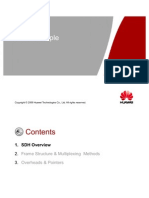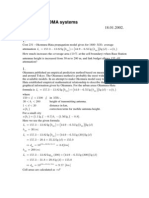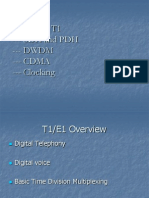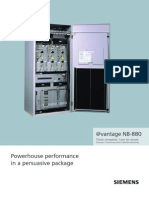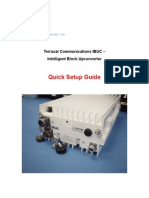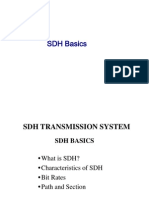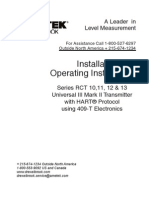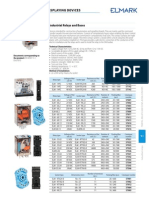SDH Principle
SDH Principle
Uploaded by
sarfrazatiqCopyright:
Available Formats
SDH Principle
SDH Principle
Uploaded by
sarfrazatiqOriginal Description:
Copyright
Available Formats
Share this document
Did you find this document useful?
Is this content inappropriate?
Copyright:
Available Formats
SDH Principle
SDH Principle
Uploaded by
sarfrazatiqCopyright:
Available Formats
BASI C PRI NCI PLE
SDH
1SDH Basic Concept
2Frame Structure And SOH
3Multiplexing And Mapping
4Synchronous Multiplexing System
5 SDH Self-healing Network
6 Clock And Timing
Summary
SDH Basic Concept
1PDH Disadvantage
Lack of international uniform rate
2M Series2M8M34M140M565M
1.5M Series
North American1.5M6.3M45M274M
J apan1.5M6.3M32M100M
Lack of international uniform optical interface standard
Add/Drop Service need a count of hardware and the Structure
is complicated
Multiplexing/De-Multiplexing need hardware step by step
Network OAM&P capability is faultiness
SDH Basic Concept
400Mb/s
100Mb/s
32Mb/s
6.3Mb/s
series of
J apan
274Mb/s
45Mb/s
6.3Mb/s
565Mb/s
139Mb/s
34Mb/s
8Mb/s
2 Mb/s 1.5Mb/s
series of
North America
series of
Europe
4
4
4
4
4
4
3
5
6
7
4
1.5Mb/s
PDH System:
SDH Basic Concept
140/34Mbit/s 34/140Mbit/s
/
Optical
signal
/
34/8Mbit/s 8/34Mbit/s
8/2Mbit/s 2/8Mbit/s
2Mbit/s
m
u
l
t
i
p
l
e
x
m
u
l
t
i
p
l
e
x
m
u
l
t
i
p
l
e
x
d
e
m
u
l
t
i
p
l
e
x
d
e
m
u
l
t
i
p
l
e
x
d
e
m
u
l
t
i
p
l
e
x
o
p
t
i
c
a
l
e
l
e
c
t
r
i
c
a
l
e
l
e
c
t
r
i
c
a
l
o
p
t
i
c
a
l
Optical
signal
SDH Basic Concept
THE PROCESS OF ADDI NG / DROPPI NG TRI BUTARI ES I N PDH
PDH System:
Faster transmission speed and more enormous capability.
More efficient multiplexing and de-multiplexing.
Worldwide uniform optical Network Node I nterface(NNI ).
Self-healing functions of transmission network.
Powerful Operation, Administration&Maintenance(OAM)
SDH Basic Concept
Requirements Of Modern Transmission Network
2SDH Character:
Advantages
Uniform Rate155M622M2.5G10G
Uniform Optical interface and Frame Structure:
STM-NN=141664
Add/Drop service only by one step;
Powerful Network OAM&P capacity
flexible networking ,the survivability of network is powerful
forward and backward compatibility
Disadvantage
The using percentage of the bandwidth is low
SDH Basic Concept
3SDH Basic Concept
3.1Hierarchy and Rate
kinds
STM-1
STM-4
STM-16
STM-64
rateMb/s
155.520
622.080
2488.320
9953.280
63
252
1008
4032
Numbers of 2M
SDH Basic Concept
3.2SDH Network Topology
. Line network
TM ADM ADM
TM
REG
. Tree network
TM
ADM ADM
TM
REG
ADM
TM
SDH Basic Concept
. Ring network
ADM
ADM
ADM
ADM
SDH Basic Concept
. Star network
TM DXC
ADM
TM
REG
ADM
TM
TM
ADM
TM
TM
SDH Basic Concept
. Mesh network
ADM
ADM
ADM
ADM
SDH Basic Concept
Frame Structure And SOH
SOHSegment overhead
AU PTRAU management pointer
POHPath overhead
9270N Byte
1
3
4
5
9
SOH
STM-N Payload
(including POH )
Direction
9N
261N
270N columns
SOH
AU PTR
T=125 us
Frame Structure And SOH
Payload
High order path layer
MSOH layer
Frame Structure And SOH
THE LEVELS OF SDH:
Low order path layer
RSOH layer
STM-N
1STM-1 SOH Bytes arrangement
9 columns
A1 A1 A1 A2 A2 A2 J 0 ~ ~
B1 E1 F1 ~ ~
D1 D2 D3
A U - P T R (AU management pointer)
B2 B2 B2 K1 K2
D4
D5 D6
D7 D8 D9
D10 D11 D12
S1 M1 E2 ~ ~
R
S
O
H
M
S
O
H
9
r
o
w
s
Direction
T=125us
Frame Structure And SOH
2 SOH byte function
1. A1A2 initial frame position bytes;
2. J 0 Regenerating segment tracing byte
3. B1Bit insertion parity correction 8 bit codes (BI P-8).
B1 Byte
Verified byte
Verified byte
Verified byte
b1 b2 b3 b4 b5 b6 b7 b8
1 1 0 0 1 0 0 1
1
1
0 1 0 0 1 0 1
0 0 1 1 0 1 0
Frame Structure And SOH
4. D1~D3RS Data communication channel
5. D4 ~D12 MS Data communication channel
6. E1E2Order-wire bytes
7. F1User channel
8. B2BI P-N24 code
9. K1K2Automatic protection switching (APS)
Frame Structure And SOH
10. S1Synchronous status byte
b5 ~b8 =0010G.811 Clock
0100G.812 Clock
1011 Equipment Clock
1111No usage
11. M1 (MS-REI ) byte
Frame Structure And SOH
Multiplexing and Mapping
1Multiplexing and mapping units
1.1Container C
C is an important information structure in SDH, which
mainly supports various digital flows.
There are three categories:
kinds
C-12
C-3
C-4
Signal category
2 Mb/s
34 / 45 Mb/s
140 Mb/s
Structure
9 42
9 84
9 260
RateMb/s
2.176
48.384
149.760
Multiplexing and Mapping
1.2Virtual Container VC
VC also is an important information structure in
SDH, which mainly supports the path layer connection.
There are three categories:
kinds
VC-12
VC- 3
VC- 4
Signal category
2 Mb/s
34 / 45 Mb/s
2/34/45/140 Mb/s
Structure
9 41
9 85
9 261
RateMb/s
2.240
48.960
150.336
Multiplexing and Mapping
VC-12 VC-3
P
O
H
C-3
( 34/45Mb/s )
85
POH
C-12
( 2Mb/s )
4
9
Multiplexing and Mapping
C-4
( 140 Mb/s )
P
O
H
261
9
3TUG-3
( 2/34/45 M )
P
O
H
261
9
VC-4 (a)
VC-4 (b)
R
2
R
1
noteTUG3 =7 TUG -12=21 TU-1263 VC12
TUG3 =TU - 3 VC-3
Multiplexing and Mapping
1.3Tributary Unit TU
TU is an information structure that performs
adaptation functions for the low order path layer and
high order path layer
Kinds
TU-12
TU- 3
I ncluding
VC12+TU12 PTR
VC3+TU3 PTR
Structure
9 4
9 85+3
RateMb/s
2.304
49.152
Multiplexing and Mapping
H1
H2
H3
TU PTR
VC-12
VC-3
9
TU-12 TU-3
4 85
9
Multiplexing and Mapping
1.4Tributary unit Group (TUG)
One or more TUs with fixed locations form a
TUG
Kinds
TUG- 3
I ncluding
3 TU-12
7 TUG-2
Structure
9 12
9 86
RateMb/s
6.912
49.536
TUG- 2
Multiplexing and Mapping
3TU - 12
7TUG-2
1TU- 3
9
TUG-2 TUG-3
R means filled bytes
12 86
9
R
R
Multiplexing and Mapping
1.5Administration unit-4 AU- 4
AU-4 Performs adaptation functions for the high
order path layer and multiplexing segment layer
AU-4 consists of high order VC and AU PTR
AU-PTR
VC - 4
9
261
9
Multiplexing and Mapping
2Pointer
2.1Purpose
I ndicate the position of payload
Rate adjustment
2.2Categories
Administration unit pointer AU PTR
Tributary unit pointer TU-3 PTRTU-12 PTR
Multiplexing and Mapping
3AU PTR
3.1Position and Structure
9
261
AU-PTR
9
H
1
Y Y H
2
1* 1* H
3
H
3
H
3
Y=1001SS11
1*=11111111
VC - 4
Multiplexing and Mapping
3.2H1H2H3 bit arrangement
N N N N S S I D I D I D I D I D
H1
H2
H3 H3 H3
NDF
10 bit pointer
Negative
adjustment
byte
AU
kinds
NDFNew data flag
SSAU categoriesSS=11AU-4
I I ncreased bits
Dreduced bits
Multiplexing and Mapping
3.3H1H2H3 byte function
. To indicate the position of Payload
. To adjust the rate of VC-4
. To indicate New Data flag (NDF)
Multiplexing and Mapping
4TU-3 PTR
4.1Position and Structure
H1
H2
H3
VC-3
9
85
TU-3
Multiplexing and Mapping
4.2H1H2H3 bit arrangement
N N N N S S I D I D I D I D I D
H1
H2
H3
NDF
10 bit pointer
Negative
adjustment
byte
AU
kinds
NDFNew data flag
SSAU categoriesSS=00TU-3
I I ncreased bits
Dreduced bits
Multiplexing and Mapping
4.3H1H2H3 Byte function
. To indicate the position of Payload
. To adjust the rate of VC-3
. New data flag (NDF)
Multiplexing and Mapping
5TU-12 PTR
5.1Position and Structure
V1
VC-12
V2
VC-12
V3
VC-12
500s
Multi-Frame
V4
VC-12
Multiplexing and Mapping
5.2V1V2V3 bit arrangement
N N N N S S I D I D I D I D I D
V1
V2
V3
NDF
10 bit pointer
Negative
adjustment
byte
AU
kinds
NDFNew data flag
SSAU categoriesSS=10TU-12
I I ncreased bits
Dreduced bits
Multiplexing and Mapping
5.3V1V2V3 Byte function
. To indicate the position of Payload
. To adjust the rate of VC-12
. New Data flag (NDF)
Multiplexing and Mapping
6High Order VC-4 / VC-3 POH
6.1 Position and Structure
VC- 4 / VC-3
J
1
B
3
C
2
G
1
F
2
H
4
F
3
K
3
N
1
Multiplexing and Mapping
6.2 POH Byte function
J 1High order path tracing byte;
B3High order path error code monitoring byte,BI P-8(code);
C2 To represent the composition of VC-3/4 structure;
G1Path status byteREI RDI ;
F2F3 User channel ;
H4To indicate the position of multi-frame;
K3Automatic protection switching (APS) byte ;
N1Network operator byte
Multiplexing and Mapping
7Low Order VC-12 POH
7.1 Position and Structure V5
VC-12
J 2
VC-12
500s
Multi-frame
VC-12
N2
K4
VC-12
Multiplexing and Mapping
7.2 Byte function
V5 Path status and signal tag byte ;
b1b2Path bit insertion parity correction 8 bit codes
(BI P-2);
b3 REI ;
b4 RFI ;
b5b6b7signal category,Mapping mode;
b8RDI ;
J 2Low order path tracing byte ;
N2 Network operator byte ;
K4 Automatic protection switching (APS) byte
Multiplexing and Mapping
8Byte I nterleaving Multiplex
Adaptation of multiple low order path layer signals to high
order path layer signal or multiple high order path layer signals
to a multiplexing segment layer.
2
b
1
2
3
1
3
1
2
3
c
a
c
b
a
TU-12 a
TU-12 b TU-12 c
TUG-2
4
4
4
Multiplexing and Mapping
9Mapping
9.1Mapping
The process of putting various tributary signals into
related VC is called mapping
For example:Putting 2Mb/s signal into VC-12
Putting 34or45Mb/s signal into VC-3
Putting 140Mb/s signal into VC-4
Multiplexing and Mapping
10 The mapping and multiplexing Structure
C 4
Adjustment
AUG
TUG-2
VC-3
C-3
TU-12
VC-12
C-12
140M
34M / 45M
2M
Pointer process
Mapping
Multiplexing
N
7
3
3
TUG3
STM-N
AU-4
VC-4
TU - 3
1
1
C-4
Multiplexing and Mapping
STM-N
N 1
C-12 VC-12 VC-4
TUG-2
AUG-4 AU-4 TU-12 2Mb/s
bit rate
adjustment
LO POH
TU PTR
AU PTR
multiplex
7multiplex
HO POH
multiplex
Nmultiplex
TUG-3
Multiplexing and Mapping
THE J OURNEY OF 2Mbit/s I N STM-N
Synchronous Multiplexing
System
1 Synchronous Multiplexing Equipment Categories
. Terminal Multiplexer (TM)
I n the end station of chain network, TM is used to
multiplex/de-multiplex the PDH/SDH tributary signals
to/from line SDH signal.
PDH/SDH tributary signal
OAM
Line signal
STM-N
TM
Synchronous Multiplexing System
. Add/Drop Multiplexer (ADM)
ADM is placed in the middle station of the network
which performs to add/drop service function
STM-N
STM-N
West signal
PDH/SDH tributary signal
OAM
East signal
ADM
Synchronous Multiplexing System
. Regenerator (REG)
REG is placed in the middle station of the network
which mainly used to amplify optical power so as to
extend the optical transmission distancebut it can not
add/drop service.
OAM
East signal
West signal
STM-N
STM-N
REG
Synchronous Multiplexing System
2Characters
1One step Multiplexing
Add/Drop tributary signalDrop 2M from 2.5G
2Powerful Cross-connect Capacity
Realize:line to line, line to tributary and tributary to tributary
cross-connection.
3Powerful OAM Capacity
4Flexible networking capacity
5Powerful network survivability
Synchronous Multiplexing System
3Cross performance indices
. Cross hierarchy
High order crossVC-4 level cross connection.
Low order crossVC-12 level cross connection
Which can guarantee to drop 2M service from high
rate service directly
Synchronous Multiplexing System
gCross capacity
Cross capacity is generally written as n n VC-4
For example:2.5G ADM provide powerful cross capacity
high order cross capacity96 96 VC-4.
Synchronous Multiplexing System
@. Cross category
Provide the following categories at least
Uni-directionThe crossed port only be used as output
Bi-directionEvery port can be used as both the input signal
port and the output signal port
BroadcastEvery input signal can connect with more ports
Synchronous Multiplexing System
4System Structure
Timing Communica
tion Unit
OW
PDH & SDH tributary interface
LI
LI
cross matrix
Synchronous Multiplexing System
4.1Line interface
Line signal STM-N O-E conversion
Process AU_PTRproduce/end SOH
4.2Cross matrix
Complete the cross-connection function of high
speed signals based on VC_4;
Add/Drop service to/from high speed signals.
Synchronous Multiplexing System
4.3Tributary interface
Add/Drop service at the station
Service Categories:2M34M45M140M155M
etc.
4.4Timing unit
I nsideProvide timing signal to internal units
OutsideTracing external timing signal
Drop timing signal from Line/Tributary signal
Holdover/oscillation
Synchronous Multiplexing System
4.5Communication and control unit
Collect data from all units
Present to NMS through DCC path
On the contrary, receive commands from NMS and
implement them.
4.6Order Wire unit
Provide order wire for contact
Synchronous Multiplexing System
SDH Self-healing Network
1.1 Self-healing Network
Self-healing network can automatically recover the
carried services from a failure fault in a very short period of
time.
1.2 Types of self-healing network
1 Line protection switching(less than 50 ms)
2 Self-healing ring network
SDH Self-healing Network
1.3 Categories of self-healing ring network
=1 Path protection switching ring
=2 Multiplex segment protection switching ring
= Unidirectional MSPS
= Bi-directional MSPS
SDH self-healing network
SDH self-healing network
Line protection switching Self-healing ring network
Path protection
switching ring
Multiplex segment protection
switching ring
Unidirectional MSPS
Bi-directional MSPS
Types of SDH self-healing network:
SDH self-healing network
CA AC
CA AC
S1
P1
P1
S1
A
B
C
D
CA AC
CA AC
S1
P1
P1
S1
A
B
C
D
Switching
Normal condition
1.4 Two-fiber Unidirectional Path Protection
Ring
SDH Self-healing Network
Principlesend together and receive first
S:service optical
P:protection optical
Normal
From A to C
SA --- B --- CPA --- D --- C
similarFrom C to A
SC --- D --- A PC --- B --- A
SDH self-healing network
CA AC
CA AC
S1
P1
P1
S1
A
B
C
D
CA AC
CA AC
S1
P1
P1
S1
A
B
C
D
Switching
Fault condition
Two-fiber unidirectional path protection switching ring
SDH self-healing network
Fault
The cable between B and C is cut off
AC servicethe signal come from A is lost
So switching to the P optical fiber.
Receive signal viaA --- D --- C
CA service is in the original way.
SDH self-healing network
1.5 Two-fiber MS-Shared Protection Ring
CA AC
CA AC
S1/P2
S2/P1
S2/P1
S1/P2
A
B
C
D
CA AC
CA AC
S1/P2
S2/P1
S2/P1
S1/P2
A
B
C
D
Switching
Normal condition
SDH self-healing network
Normal
AC signals are transmitted along S1/P2 optical fiber in
clock direction while CA signals along S2/P1 in
anticlockwise direction.
From A to C
SA --- B --- C
From C to A
SC --- B --- A
P1 and P2 can transmitted additional service.
SDH self-healing network
CA AC
CA AC
S1/P2
S2/P1
S2/P1
S1/P2
A
B
C
D
CA AC
CA AC
S1/P2
S2/P1
S2/P1
S1/P2
A
B
C
D
Switching
Fault condition
SDH self-healing network
Two-fiber MS-Shared Protection Ring
Fault:
The cable between B and C is cut off
AC servicethe signal come from A is lost
So switching to the P optical fiber.
Receive signal viaA --- D --- C
CA service is in the original way.
At B node: Switching to the anticlockwise direction A---B-
-- A --- D --- C
At C node Switching to the clockwise direction C --- D -
-- A
SDH self-healing network
Network Synchronization
1Multiple Clock sources
. External clock source
. Drop clock source from STM-N interface
. I nternal clock source
A). Holdover mode
Utilize pre-24hours memory information to stimulate
synchronous status
precision index0.37ppm
B). oscillation
precision index 4.6ppm
Network Synchronization
Network Synchronization
1 Network synchronization
Network synchronization is one important part in the network.
Which can ensure the transmitting end and the receiving end
working in the synchronous status.
2 SSM function
SSM is transferred by the fifth to the eighth bits of S1 byte.
b1 b2 b3 b4
b5 b6
b7
b8
SSM
These four bits have 16 different kinds of codes
representing 16 different synchronization quality grades
Network Synchronization
3 Selection of clock source
The NE first selects the clock of highest quality grade.
The NE selects the clock source which passes the least
numbers of NE.
Thanks!
You might also like
- OTC000005 OTN Introduction ISSUE1.00Document73 pagesOTC000005 OTN Introduction ISSUE1.00Mohammed Kumayl100% (1)
- Digital Modulation Course NotesDocument11 pagesDigital Modulation Course NotesAli Aslam100% (1)
- BTEL Radio Transmission ATP Form v1.6Document19 pagesBTEL Radio Transmission ATP Form v1.6supriadi suhariNo ratings yet
- ACS800-307 (-507) User Manual Diode Supply (C)Document82 pagesACS800-307 (-507) User Manual Diode Supply (C)boba78100% (3)
- Sdh/Sonet: Alarms & Performance MonitoringDocument141 pagesSdh/Sonet: Alarms & Performance MonitoringMohammed KumaylNo ratings yet
- Ota000004 SDH Principle Issue 2.30Document48 pagesOta000004 SDH Principle Issue 2.30Allan MwennyNo ratings yet
- A Presentation On An Industrial Training Taken at CTTC-Kolkata (BSNL)Document26 pagesA Presentation On An Industrial Training Taken at CTTC-Kolkata (BSNL)Tajinder SinghNo ratings yet
- Microwave LinkDocument21 pagesMicrowave LinkhewagelmNo ratings yet
- SC-FDMA in LTEDocument16 pagesSC-FDMA in LTENgọc Nhã100% (1)
- Part 3. Multiplexing PDH SDHDocument59 pagesPart 3. Multiplexing PDH SDHMahesh SinghNo ratings yet
- 6 Microwave Comm System PDFDocument42 pages6 Microwave Comm System PDFJeffreyBeridaNo ratings yet
- TJ 1400 OLT BrochureDocument2 pagesTJ 1400 OLT BrochureShine JosephNo ratings yet
- Telecom Basics For BUGSDocument37 pagesTelecom Basics For BUGSGurpreet SinghNo ratings yet
- Transmission SynchDocument47 pagesTransmission SynchMakarand DereNo ratings yet
- 3000 Series 4 - 11 GHZ Stm-1/Oc-3 Microwave Radio SystemDocument41 pages3000 Series 4 - 11 GHZ Stm-1/Oc-3 Microwave Radio SystempathlossanwarNo ratings yet
- Configuring SDH Cross-ConnectsDocument15 pagesConfiguring SDH Cross-Connectslatinocomm2009No ratings yet
- Quadrature Amplitude Modulation (QAM) ReceiverDocument12 pagesQuadrature Amplitude Modulation (QAM) ReceiverAhmed HamoudaNo ratings yet
- UMTS Key TechnologiesDocument64 pagesUMTS Key Technologieswalt_077No ratings yet
- Digital Microwave Communication PrinciplesDocument113 pagesDigital Microwave Communication Principleskaz7878No ratings yet
- PDH SDH PresentationDocument67 pagesPDH SDH PresentationDanish Ahmed100% (3)
- Basic KnowledgeDocument41 pagesBasic KnowledgesarfrazatiqNo ratings yet
- Link Aggregation: "IEEE 802.3ad" Redirects Here. It Is Not To Be Confused WithDocument6 pagesLink Aggregation: "IEEE 802.3ad" Redirects Here. It Is Not To Be Confused WithMohamed WahiebNo ratings yet
- Microwave Nec Pasolink Neo by Akash RayDocument48 pagesMicrowave Nec Pasolink Neo by Akash RayAntonio P. Souza JuniorNo ratings yet
- Pasolink Neo InstallationDocument38 pagesPasolink Neo InstallationVVO1No ratings yet
- What Och OduDocument12 pagesWhat Och OduxiwayNo ratings yet
- HCIE Interview Questions by SherazDocument42 pagesHCIE Interview Questions by SherazAdnan KhanNo ratings yet
- 01-OptiX RTN 900 V100R002 Product Description-20100223-ADocument54 pages01-OptiX RTN 900 V100R002 Product Description-20100223-AMohamed SamirNo ratings yet
- Digital Switching ConceptsDocument25 pagesDigital Switching ConceptsDutta AvinashNo ratings yet
- Presentation Basics OPTIX RTN (605, 610, 620)Document73 pagesPresentation Basics OPTIX RTN (605, 610, 620)Noman Sarwar100% (1)
- Tutorial1 Sol 180102Document9 pagesTutorial1 Sol 180102Punky HeroNo ratings yet
- MSGR94 BS8700 EOL N Jan'13: Site ID Site Type Rectifier IPS Required Month in SNCDocument16 pagesMSGR94 BS8700 EOL N Jan'13: Site ID Site Type Rectifier IPS Required Month in SNCMuhammad AqeelNo ratings yet
- Fault Tolerant Ethernet Delivers Robust Networking Solution For Experion PKSDocument6 pagesFault Tolerant Ethernet Delivers Robust Networking Solution For Experion PKSKhalid AliNo ratings yet
- Exercise Ofdm Ieee 802 11a PDFDocument13 pagesExercise Ofdm Ieee 802 11a PDFmhaabNo ratings yet
- Alcatel Presentation GPONDocument20 pagesAlcatel Presentation GPONAhmed El-OsailyNo ratings yet
- Interference & Frequency PlanningDocument64 pagesInterference & Frequency PlanningFahrizal IlhamNo ratings yet
- IS-54 Dan IS-136Document29 pagesIS-54 Dan IS-136hasbiiie100% (1)
- Sar Isc S&T100 Tele 0005Document55 pagesSar Isc S&T100 Tele 0005binoynsNo ratings yet
- Optical Transport NetworkDocument4 pagesOptical Transport NetworknarayanbscribidNo ratings yet
- E1 and t1 SDH and PDH DWDM Cdma ClockingDocument44 pagesE1 and t1 SDH and PDH DWDM Cdma ClockingsajjadashrafNo ratings yet
- PCM PDH and SDHDocument58 pagesPCM PDH and SDHAkram Ba-odhan100% (1)
- Itu-T: Mean Opinion Score (MOS) TerminologyDocument18 pagesItu-T: Mean Opinion Score (MOS) TerminologyRomaric NoutaiNo ratings yet
- MSK ModulationDocument4 pagesMSK ModulationAvtar SinghNo ratings yet
- RTN 900 Brochure (910&950) V2.0Document4 pagesRTN 900 Brochure (910&950) V2.0Juan Antonio GranadosNo ratings yet
- Teletraffic Engineering and Network PlanningDocument14 pagesTeletraffic Engineering and Network PlanningMuhammad RidlonNo ratings yet
- Siemens NodeB NB-880Document4 pagesSiemens NodeB NB-880antothNo ratings yet
- RTN 950Document2 pagesRTN 950Farid AbbasiNo ratings yet
- Quick Setup Guide: Terrasat Communications IBUC - Intelligent Block UpconverterDocument10 pagesQuick Setup Guide: Terrasat Communications IBUC - Intelligent Block UpconverterGenka BuchukuriNo ratings yet
- Microwave Filters for Communication Systems: Fundamentals, Design, and ApplicationsFrom EverandMicrowave Filters for Communication Systems: Fundamentals, Design, and ApplicationsNo ratings yet
- Optical and Microwave Technologies for Telecommunication NetworksFrom EverandOptical and Microwave Technologies for Telecommunication NetworksNo ratings yet
- LTE Self-Organising Networks (SON): Network Management Automation for Operational EfficiencyFrom EverandLTE Self-Organising Networks (SON): Network Management Automation for Operational EfficiencySeppo HämäläinenNo ratings yet
- Making Telecoms Work: From Technical Innovation to Commercial SuccessFrom EverandMaking Telecoms Work: From Technical Innovation to Commercial SuccessNo ratings yet
- Basic Principles of SDHDocument112 pagesBasic Principles of SDHsarfrazatiq100% (1)
- 1.SDH BasicsDocument66 pages1.SDH BasicsSwati Chandran100% (8)
- SDH BasicsDocument107 pagesSDH Basicskahroba151100% (1)
- SDH BasicsDocument54 pagesSDH BasicsWaad AlteeNo ratings yet
- SDH Basics: Girish JereDocument21 pagesSDH Basics: Girish JereBhavesh RathodNo ratings yet
- OTA000001 SDH Review2005Document40 pagesOTA000001 SDH Review2005Luong NguyenNo ratings yet
- Comparison Four Fiber and Two Fiber ProtectionDocument9 pagesComparison Four Fiber and Two Fiber ProtectionsarfrazatiqNo ratings yet
- Brief Introduction To SDHDocument65 pagesBrief Introduction To SDHsarfrazatiqNo ratings yet
- Basic KnowledgeDocument41 pagesBasic KnowledgesarfrazatiqNo ratings yet
- Basic Principles of SDHDocument112 pagesBasic Principles of SDHsarfrazatiq100% (1)
- Design and Analysis of Open Loop Control Boost ConverterDocument7 pagesDesign and Analysis of Open Loop Control Boost ConverterDHINESH JNo ratings yet
- 8 CH Ahd DVR: SA-8200AHD-2L (MM)Document1 page8 CH Ahd DVR: SA-8200AHD-2L (MM)FabiolaNo ratings yet
- Bluestar LTD - ProductsDocument5 pagesBluestar LTD - ProductsRiyas MohamedNo ratings yet
- FT100DDocument4 pagesFT100Dleo1963No ratings yet
- 180kVA STCDocument34 pages180kVA STCAakarsh RastogiNo ratings yet
- IT For Management: On-Demand Strategies For Performance, Growth, and SustainabilityDocument37 pagesIT For Management: On-Demand Strategies For Performance, Growth, and SustainabilityKiky Audrya HardiantiNo ratings yet
- Travelmate 2350: Service GuideDocument90 pagesTravelmate 2350: Service Guidesrinivas1572No ratings yet
- PLC MCQ Unit5Document4 pagesPLC MCQ Unit5pradnya sadigaleNo ratings yet
- S32G2RSERDESRMDocument990 pagesS32G2RSERDESRMteenjustmeNo ratings yet
- LED OutDoor ID Display PriceDocument3 pagesLED OutDoor ID Display PriceSatish Phakade-PawarNo ratings yet
- EECS 465: Digital Systems Design Lecture Notes: Logic Design Using Compound Components: Multiplexers Shantanu DuttDocument26 pagesEECS 465: Digital Systems Design Lecture Notes: Logic Design Using Compound Components: Multiplexers Shantanu DuttJbanfulNo ratings yet
- Signal Splitter Configurable MCR-FL-C-UI-2UI-DCI: 1. DescriptionDocument5 pagesSignal Splitter Configurable MCR-FL-C-UI-2UI-DCI: 1. Descriptionahmed1974No ratings yet
- Assembling The Arduino Diecimila Compatible Freeduino Board USBDocument8 pagesAssembling The Arduino Diecimila Compatible Freeduino Board USBMC. Rene Solis R.No ratings yet
- Datasheet PDFDocument14 pagesDatasheet PDFDavidCaloNo ratings yet
- C.00B0.KC14.9323-E05/ASZ011 1 3 A3 02: SiemensDocument3 pagesC.00B0.KC14.9323-E05/ASZ011 1 3 A3 02: Siemensandrei.ciobanasuNo ratings yet
- Vlsi Design FlowDocument22 pagesVlsi Design FlowAniket PawadeNo ratings yet
- ISRO Rank-1 EC Interview Experience - QuoraDocument3 pagesISRO Rank-1 EC Interview Experience - QuoraarajNo ratings yet
- RCT ManualDocument102 pagesRCT ManualbujegaNo ratings yet
- Product Data Sheet: Circuit Breaker Compact NSX400F - Micrologic 1.3 M - 320 A - 3 Poles 3dDocument3 pagesProduct Data Sheet: Circuit Breaker Compact NSX400F - Micrologic 1.3 M - 320 A - 3 Poles 3dtcmNo ratings yet
- JUNIOR - ARDF Direct Conversion Receiver For The 80 M BandDocument9 pagesJUNIOR - ARDF Direct Conversion Receiver For The 80 M Bandag1tatorNo ratings yet
- Advanced Progressive Scan: Operating InstructionsDocument36 pagesAdvanced Progressive Scan: Operating InstructionsjohnecnNo ratings yet
- Vlsi Design Flow: RTL To GDS: Prof. Sneh SaurabhDocument2 pagesVlsi Design Flow: RTL To GDS: Prof. Sneh SaurabhSunil KumarNo ratings yet
- Commscope Trunk & Distribution Cable ProductsDocument51 pagesCommscope Trunk & Distribution Cable ProductsMauro Barragan SanchezNo ratings yet
- DIY 137MHz WX-sat V-Dipole Antenna-1Document8 pagesDIY 137MHz WX-sat V-Dipole Antenna-1John DoeNo ratings yet
- Product SpecificationDocument4 pagesProduct SpecificationTiago GonçalvesNo ratings yet
- Flyer - PCS-902 Line Distance ProtectionDocument3 pagesFlyer - PCS-902 Line Distance ProtectionYM6BNo ratings yet
- Relee ElmarkDocument2 pagesRelee ElmarkwawinNo ratings yet
- Comparison of Wireless TechnologiesDocument2 pagesComparison of Wireless TechnologiesMuhammad SalmanNo ratings yet
- HT0740 High Voltage, Isolated MOSFET Driver: Features General DescriptionDocument4 pagesHT0740 High Voltage, Isolated MOSFET Driver: Features General DescriptionsmhbNo ratings yet





